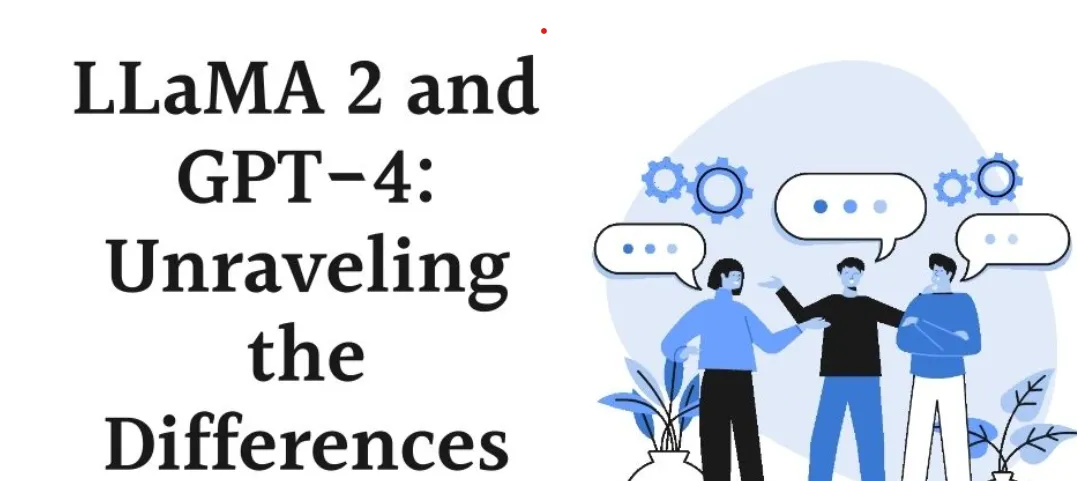9 Key Differences Between GPT4 & Llama2 One Should Know

In the rapidly evolving realm of advanced language models, two formidable contenders have risen to prominence, each possessing its own remarkable capabilities and unique strengths.
On one side, we have GPT-4, the brainchild of OpenAI, which dazzles with its unprecedented number of parameters and groundbreaking ability to not only process text but also delve into the realm of image processing, offering a versatile tool with a myriad of applications.
On the opposing front, there's LLaMA 2, a collaborative creation between Meta and Microsoft, renowned for its exceptional prowess in handling multiple languages, computational efficiency, and its welcoming open-source nature, which beckons researchers and developers to explore its intricacies.
In this comprehensive analysis, we will embark on a journey to uncover the fundamental distinctions between GPT-4 and LLaMA 2, unveiling their distinct attributes and potential impacts within the expansive domain of AI and natural language processing.
In-Depth Look at GPT-4
GPT-4, introduced by OpenAI in March 2023, represents a significant leap forward in the field of Language Model (LLM) technology. While it certainly builds upon the strengths of its predecessor, GPT-3.5, what truly distinguishes it is its groundbreaking ability to process not only textual data but also images.
This multimodal capacity positions GPT-4 as an incredibly versatile tool with a broad spectrum of potential applications, greatly expanding its usefulness beyond what was achievable with earlier iterations.
This newfound capability allows GPT-4 to seamlessly integrate and analyze both text and visual information, opening up exciting possibilities across various domains.
It can enhance natural language understanding and generation by incorporating visual context, which is especially valuable for tasks like generating descriptive captions for images or aiding in content creation for visually rich platforms.

Moreover, GPT-4's capacity to handle image inputs opens doors to advanced applications in fields such as computer vision, where it can assist in tasks like image recognition, object detection, and even medical image analysis. This convergence of text and image processing has the potential to revolutionize industries reliant on data analysis and interpretation.
However, it's essential to acknowledge that this expanded capability comes with a price tag. GPT-4 stands as the most expensive LLM currently available in the market due to the increased computational demands associated with processing both text and images. Organizations and individuals considering its adoption should be prepared for the associated costs.
Variants of GPT-4: ChatGPT Plus and gpt-4-32K
OpenAI has introduced GPT-4 in two distinctive variants, each finely tuned to cater to specific user needs.
The first variant, known as "gpt-4-8K," serves as the driving force behind ChatGPT Plus, a subscription-based service that harnesses the model's capabilities to enhance conversational experiences.
On the other hand, the second variant, "gpt-4-32K," is engineered to tackle more extensive and intricate tasks, meeting the demands of users with advanced requirements.
While it might initially appear that GPT-4's claim as the "most powerful Language Model" should render discussions about its competition, such as LLaMA 2, obsolete, the reality is more nuanced. Assessing the relative merits of these models demands a deeper exploration.

In this context, GPT-4's tailored variants signify OpenAI's commitment to accommodating a broad range of user needs. ChatGPT Plus, powered by "gpt-4-8K," excels in providing rich conversational interactions, making it a valuable tool for engaging with users. Meanwhile, "gpt-4-32K" steps in for tasks demanding higher complexity and depth, demonstrating the model's versatility.
However, the competition remains relevant. Models like LLaMA 2 may excel in specific areas, such as multilingual support and computational efficiency, making them formidable alternatives for particular use cases.
The landscape of advanced language models is dynamic, and while GPT-4's variants represent a significant leap, it's crucial to recognize the unique strengths of each model to make informed choices in adopting AI solutions.
In-Depth Look at Llama 2
LLaMA 2, developed by Meta, is a versatile AI model that incorporates chatbot capabilities, putting it in direct competition with similar models like OpenAI's ChatGPT.
It stands out for its accessibility, as it can be freely downloaded from platforms such as Microsoft Azure, Amazon Web Services (AWS), and Hugging Face, allowing developers, researchers, and tech enthusiasts to experiment with its capabilities.
However, there are concerns regarding the transparency of LLaMA 2's training data, as Meta has not disclosed whether it includes copyrighted content or personal data, raising potential privacy issues.
Like many large language models, LLaMA 2 faces challenges related to generating offensive content and spreading false information, making responsible use a significant concern.

Meta's decision to release LLaMA 2 as an open-source model underscores their commitment to community-driven improvements. They encourage user feedback and experiences to help address safety, efficiency, and bias issues.
Interestingly, despite being a potential competitor to OpenAI's ChatGPT, Microsoft, a significant supporter of OpenAI, has been announced as the preferred partner for LLaMA 2. This partnership highlights the collaborative nature of advancements in AI technology.
In conjunction with the launch of LLaMA 2, Meta has initiated the Llama Impact Challenge, aiming to encourage the use of the model to tackle significant societal challenges and leverage AI's potential for positive societal change.
GPT4 vs Llama2: Key Differences based on 9 Parameters
1. Model Size and Parameters
GPT-4 Parameters: OpenAI has not officially disclosed the exact parameter count for GPT-4, but estimates suggest it could range from 1 to 1.76 trillion parameters. Some experts even speculate that it consists of eight separate models, each with around 220 billion parameters, making it substantially larger and more intricate than Llama 2.
Llama 2 Parameters: Llama 2 offers various configurations, including 7 billion, 13 billion, and 70 billion parameters. However, even the largest variant of Llama 2, with 70 billion parameters, pales in comparison to the potential scale of GPT-4. Llama 2's model size is notably smaller.
2. Multilingualism
GPT-4 Multilingualism: GPT-4 is primarily optimized for the English language and tends to perform poorly in languages other than English. It is not the ideal choice for tasks that require multilingual capabilities.
Llama 2 Multilingualism: Llama 2, on the other hand, is designed to excel in multiple languages. Its robust multilingual capabilities make it a suitable choice for projects that require support for a wide array of languages.
3. Token Limit
GPT-4 Token Limit: GPT-4 offers models with a significantly larger token limit compared to Llama 2. While the exact token limit is not specified, it's mentioned that the base variant of GPT-4 doubles the token limit of GPT-3.5-turbo, allowing it to process longer inputs and generate longer outputs.
Llama 2 Token Limit: Llama 2 has a token limit similar to the base variant of GPT-3.5-turbo. This means that it can process shorter inputs and generate comparatively shorter outputs than GPT-4.
4. Creativity
GPT-4 Creativity: GPT-4 is renowned for its high level of creativity when generating text. It can craft content like poems using sophisticated vocabulary, metaphors, and a wide range of expressions, resembling the work of an experienced writer.
Llama 2 Creativity: While Llama 2 is also capable of generating creative text, its creativity is generally considered to be at a lower level compared to GPT-4. Its outputs often align more closely with basic or school-level assessments.
5. Accuracy and Task Complexity
GPT-4 Accuracy and Task Complexity: GPT-4 outperforms Llama 2 across various benchmark scores, especially in complex tasks. It is recognized as a more advanced model, excelling in tasks that demand high accuracy and complexity.
Llama 2 Accuracy and Task Complexity: Llama 2 performs commendably and is competitive with GPT-3.5 in terms of accuracy. It leverages a technique known as Ghost Attention (GAtt) to enhance accuracy and control in dialogues. However, it might not match GPT-4's performance in the most intricate tasks.
6. Speed and Efficiency
GPT-4 Speed and Efficiency: Llama 2 is often considered faster and more resource-efficient compared to GPT-4. GPT-4's larger size and complexity may require more computational resources, potentially resulting in slower performance in comparison.
Llama 2 Speed and Efficiency: Llama 2 excels in terms of computational agility, offering faster inference times and more efficient resource utilization. Its architectural innovations, including grouped-query attention, contribute to this efficiency by striking a balance between accuracy and inference speed.
7. Usability
GPT-4 Usability: GPT-4 is accessible primarily through a commercial API and is targeted towards expert developers with a strong track record. It is not as openly available as Llama 2.
Llama 2 Usability: Llama 2 is integrated into the Hugging Face platform, making it more accessible to developers and researchers. However, some large companies, like Google, may still require special permissions for its use.

8. Training Data
GPT-4 Training Data: Although the exact number of tokens used to train GPT-4 is not disclosed, it's estimated to have been trained on a massive dataset of around 13 trillion tokens. This extensive training data contributes to its broad knowledge base.
Llama 2 Training Data: Llama 2, in contrast, was trained on a smaller dataset of 2 trillion tokens from publicly available sources. While it has undergone data cleaning, updates, and technical enhancements, its training data is significantly smaller than that of GPT-4.
9. Performance Metrics
GPT-4 Performance Metrics: GPT-4 consistently outperforms Llama 2 across various benchmark scores, including the HumanEval (coding) benchmark, where it significantly surpasses Llama 2 in coding skills. This highlights its superior performance in specific tasks, especially mathematical and reasoning tasks. GPT-4 also excels in few-shot learning scenarios, making it proficient in handling limited data situations and complex tasks.
Tabular Comparison between Llama 2 and GPT-4

Conclusion
The comparison between GPT-4 and LLaMA 2 reveals an intriguing contrast in the world of advanced language models. GPT-4 is a behemoth in terms of its parameters, offering incredible versatility and human-like interaction capabilities.
It closely emulates human comprehension, making it a standout choice for complex language tasks. Conversely, LLaMA 2 shines with its exceptional multilingual support, computational efficiency, and open-source nature. It excels in providing accessible AI tools for developers and researchers, offering a different dimension to the landscape of language models.
Together, GPT-4 and LLaMA 2 mark a significant leap in AI, pushing the boundaries of language understanding and generation, and opening up new avenues for innovation and application in the field.
Uncertain which large language model (LLM) to choose?
Read our other blog on the key differences between Llama 2, GPT-3.5, and GPT-4.
Frequently Asked Questions
1) What is the difference between Llama 2 and GPT-4?
When we analyze LLaMA 2 and GPT-4, it becomes clear that each model possesses distinct advantages and disadvantages. LLaMA 2 shines through its simplicity and efficiency, delivering impressive performance even with a smaller dataset and limited language support.
Its accessibility and competitive results make it an attractive choice for specific applications.
2. Can llama 2 run on a single GPU?
Yes, one notable feature of LLaMA 2 is its ability to efficiently operate on a single GPU, making it a highly practical choice for a wide array of applications. As for its multilingual capabilities, LLaMA 2 extends its support to 20 languages.
While this may not match the breadth of GPT-4's language repertoire, it nonetheless encompasses a considerable and diverse linguistic spectrum, catering to a range of communication needs.
3. How does Llama 2 improve performance?
Expanding upon its predecessor, LLaMA 2 has introduced enhancements like an extended context length and grouped-query attention. These architectural improvements allow the model to better understand the nuances of diverse inputs, ultimately optimizing its performance across various tasks.
Furthermore, in the realm of computational efficiency, LLaMA 2 holds a slight advantage, as it boasts greater speed and resource efficiency.
4. How many languages does Llama 2 support?
LLaMA 2 provides support for 20 languages, which, while not as extensive as GPT-4's multilingual capabilities, still encompasses a significant and diverse linguistic range.
Book our demo with one of our product specialist
Book a Demo
